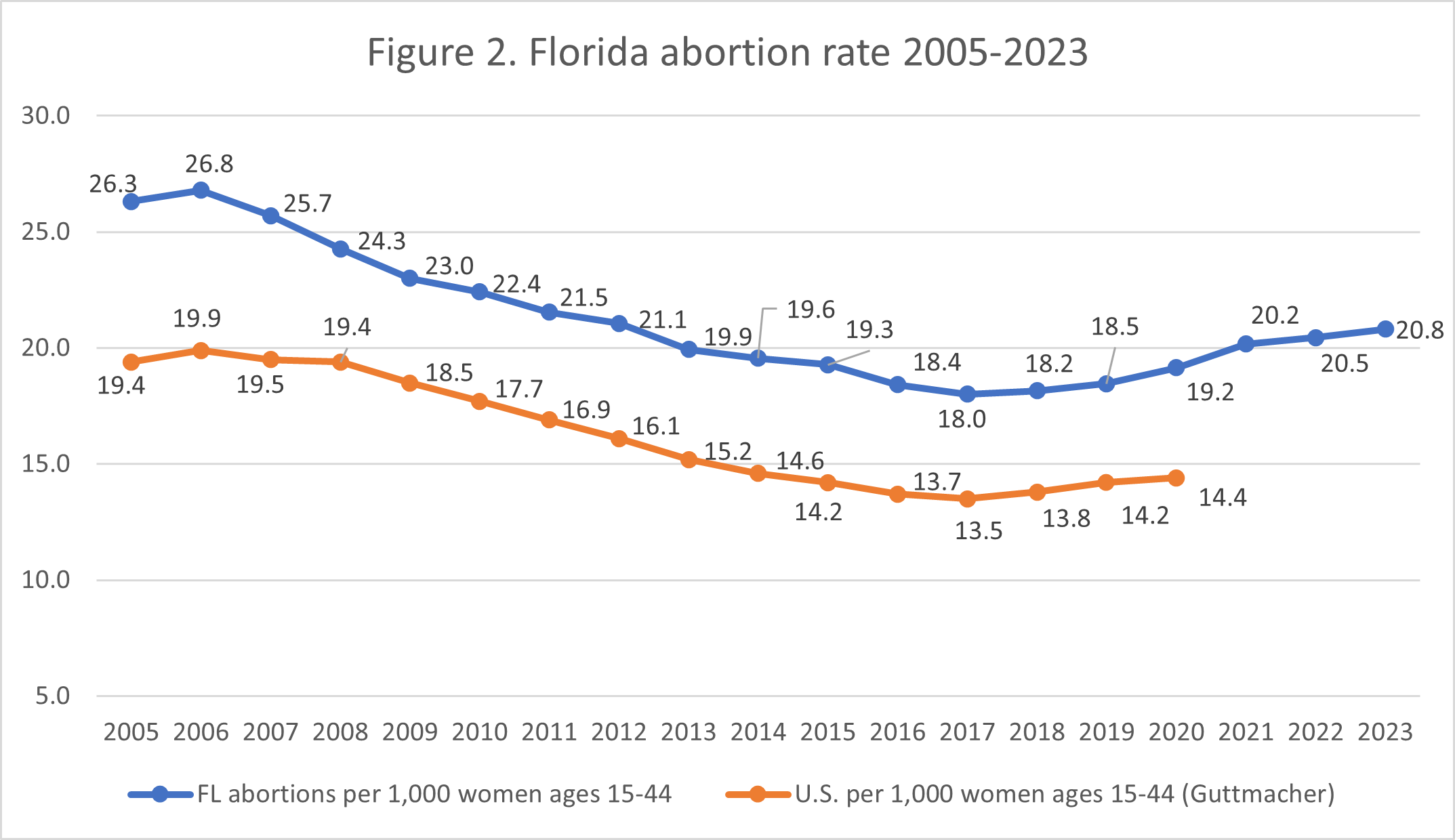Abortion Reporting: Florida (2023)
Florida publishes some of its abortion reporting tables on the state’s Agency for Health Care Administration (ACHA) website. The full report was provided to the Charlotte Lozier Institute (CLI) upon request in March 2024. This is CLI’s first published summary of a state’s 2023 abortion statistics.
Abortion Totals and Trends
Over 84,000 abortions were reported in 2023, an increase of 2% from the previous year. Of the 84,052 abortions performed in 2023, 46,635 were drug-induced, amounting to 55% of the total and up 3% from 2022 (Fig. 1). CLI estimates that Florida’s 2023 abortion rate was 20.8 abortions per 1,000 women ages 15 to 44, up 2% from 2022 (Fig. 2).1
There were 1,344 abortions at 15 weeks or later performed in Florida in 2023, down 33% from 2022.
State Report Summary
Ninety-one percent of Florida abortions were performed on state residents in 2023, while 9% were performed on women from other states. This included 4% of the Florida total performed on women from Georgia and 2% on women from Alabama. Seven percent of Florida abortions were performed on girls under the age of 20, 27% on women ages 20 to 24, and 28% on women ages 25 to 29. Just over a third (34%) of Florida abortions were performed on women in their thirties, and 4% were on women ages 40 and older.
Forty-nine percent of the abortions were performed on white women, and 36% on black women. CLI estimates that Florida’s black abortion rate was 36.8 abortions per 1,000 women of childbearing age, nearly three times the white abortion rate of 14.3. Seven percent of the abortions were performed on women of other races, while another 7% were on women of unknown races. Thirty-one percent of Florida abortions were on Hispanic women, 62% on non-Hispanic women, and 7% on women of unknown ethnicity.
Ten percent of the abortions were on married women and 74% on unmarried women, while 16% were obtained by women whose marital status was not reported. Forty-one percent of abortions were performed on women with no previous live births, 26% on women with one live birth, and 34% on women with two or more live births. Over half the women undergoing abortions (58%) reported zero prior abortions, while 23% reported one prior abortion and 18% more than one.
More than half the abortions in Florida in 2023 were drug-induced (55%). Forty-one percent were curettage procedures, and a different or unreported method was used for 3%. Three abortions were performed via hysterotomy or hysterectomy.
In 2022, Florida began measuring gestational age from the last menstrual period rather from the estimated date of fertilization, as it did in previous years. Fertilization typically occurs approximately two weeks after the last menstrual period. Compared to 2022, in 2023, abortions in Florida were more often performed between seven and 14 weeks of gestation. As reported using the new definition, in 2023, 40% of Florida abortions (33,453 abortions) were performed at six weeks of gestation or earlier, a significant decrease from 2022 when 56% were performed at six weeks or earlier. In 2023, 60% (50,599 abortions) were performed at seven weeks or later. Thirty-two percent were performed between seven and eight weeks, an increase from 23% in 2022. Fifteen percent occurred between nine and 10 weeks of gestation. Six percent were performed between 11 and 12 weeks, 5% between 13 and 14 weeks, and 1% between 15 and 17 weeks. There were 71 abortions (0.1%) performed between 18 and 20 weeks of gestation, a decrease of 87% from 2022, and 38 abortions (0.05%) were performed at 21 weeks of gestation or later, a decrease of 82% from 2022. Overall, abortions at 15 weeks or later dropped 33% from 2022. The decrease in later-term abortions is likely due to Florida’s limit on abortion after 15 weeks of gestation (except in certain cases), which went into effect in July 2022.
In April 2024, the Supreme Court of Florida upheld Florida’s 15-week limit and the state’s heartbeat law, which limits abortion after six weeks of gestation.
Fourteen babies were reported to have been born alive during abortion procedures in Florida in 2023, similar to the 16 babies reported to have been born alive in 2022. The report does not indicate the gestational ages of the babies or what happened to them after they were born.
Seventy-one percent of Florida abortions were reported as “elective,” 23% were performed for social or economic reasons, and 3% were performed for the mother’s emotional or psychological health. In contrast, only 2% were performed for the mother’s physical health and less than 1% because the unborn baby had a health condition (0.4% for a “serious abnormality” and 0.2% for a “fatal abnormality”). There were 251 abortions (0.3%) performed because of risk to the mother’s life, 107 (0.1%) due to rape, 11 due to incest, and two due to human trafficking.
Abortion Clinic Annual Report
In accordance with Section 390.012 (8) of the Florida Statute Code, AHCA must submit a report to the President of the Senate and Speaker of the House of Representatives recapping all regulatory actions related to abortion centers taken by the agency over the course of that year. ACHA’s 2023 report reveals key statistics about abortion centers operating in the state:
- There were 52 licensed abortion clinics (excluding licensed hospitals and physicians’ offices) in 16 counties. Forty-two of the 52 clinics were licensed as first- and second-trimester abortion clinics, while 10 were licensed for the first trimester only. Miami-Dade County had the highest number of first- and second-trimester abortion clinics, with six in Miami, three in Hialeah, and one in Miami Gardens.
- Licensed abortion clinics submitted 100% of the required induced termination of pregnancy reports.
- The agency conducted 81 on-site inspections, including follow-up visits. There were 54 licensure inspections and 22 complaint inspections.
- One clinic requested that its licensure be terminated.
- There were 54 abortion clinic applications, including 25 renewal applications; 27 change applications (24 personnel changes, one change of address, one change of hours of operation, and one request to terminate a license); and two new applications (both of which were denied).
- ACHA initiated 11 administrative actions in response to eight late ITOP submissions, one survey citation, one initial licensure application denied on the basis of a “demonstrated pattern of deficient performance,” and one facility failing to keep its roster of staff background checks updated.
Concerningly, “deficient practice” was found during three licensure inspections and two complaint investigations. There was one instance each of:
- Failure to ensure specimen storage space was monitored and maintained for accurate temperature
- Failure to provide an explanation of ultrasound images by a qualified staff member
- Failure to maintain complete clinical records
- Failure to maintain a log of procedures by date and gestational age
- Failure to keep staff background screenings current
While Florida does not report abortion complications with the rest of its annual abortion statistics, data for any incident resulting in serious injury to a patient or viable fetus during a second trimester abortion is recorded in the annual clinic report. In 2023, seven second-trimester clinics submitted a total of 11 reports with a total of 16 injuries: six cases of hemorrhage/excessive bleeding, three cases of a perforated uterus, one cervical injury, one other, unknown incident that required specialized medical attention, and five conditions that required hospitalization.
State Ranking
In CLI’s 2016 survey of abortion reporting across the country, Florida was ranked as 40th best. The Sunshine State significantly improved its reporting standards in 2017, but could make further improvements by providing more information about the babies who survive abortions and information on all complications that occur, not just those that occur during the second trimester and beyond.


- National rates were calculated by the Guttmacher Institute. Florida rates were calculated by CLI using the following formula: (total number of abortions performed in Florida ÷ number of resident women ages 15-44 [based on most recent population estimates]) x 1,000. Rates may differ slightly from previous CLI articles due to revised population estimates. Population estimates were obtained from the CDC WONDER database. Estimates for 2005-2009 are intercensal estimates of the July 1 resident population. Estimates for 2010-2019 are Vintage 2020 postcensal estimates of the July 1 resident population. Estimates for 2020-2022 are Vintage 2022 postcensal estimates of the July 1 resident population. Estimates were produced by the U.S. Census Bureau and the National Center for Health Statistics. Rates for 2023 were calculated using the Vintage 2022 postcensal estimates because 2023 population estimates have not yet been released by the CDC.

























